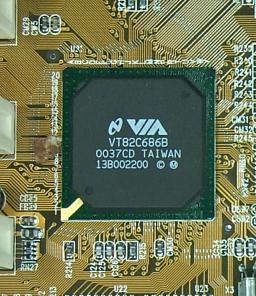
|
The fruits brought forth from AMD's newest line of processors, namely the Duron and the "Thunderbird", not only delivered excellent performance at a very low price, but also boasted of a tremendous potential for overclocking.
85% Rating: 
|
|
|
|
Home >
Reviews >
Motherboards >
Soltek 75KV2 |
|
|
First Impressions
In effect, the 75KV2 X has a
layout very similar to that of the older 75KV with the differences only being
the added features in the former. Closing in, the first item we looked for are
the DIP switch boxes used in overclocking the CPU. We were just a bit beyond
satisfied in what we saw. Adjacent to the 2 DIP switch boxes (one of them used
for multiplier settings, the other for FSB speed adjustment) is a red LED
indicator which lights up when the
system is overclocked.
More specifically, the lights turns on when when the
system is running according to the manual DIP switch adjustment and not
the default settings. If you plan to install this motherboard into a cabinet
(and most of you will), do note that accessing the boxes is a bit cumbersome
compared to having the switches on the south end of the
motherboard.
Located on the opposite end of the board is a integrated
circuit which is responsible for providing the 75KV2 X with VD Tech (or Voice Diagnosis
Technology).
As this board was design with overclocking in mind, a thought passed our
minds that perhaps Soltek would have incorporated capacitors with a higher
uf rating than previous models.
However, we
were to see this motherboard with an identical number (and type) of capacitors (5
3300 uF and 4 2200uF) being used.
It is possible that Soltek presumes that their boards are stable enough
and do not need extra capacitors present. Whatever the case may be, we shall
soon find out how well it performed. Nevertheless, it is obvious that Soltek
made a conscious effort to provide what the overclocker needs. We were pleased
to see an additional fan header which brings the total number to 3. In addition, Soltek has provided an ample amount of
real estate around the Socket A interface for a decent sized cooling
solution.
With respect to the remaninig layout of the board, we found it to be rather
clean and unobtrusive.
The 686B
Southbridge
Before the launch
of native chipset support for ATA/100, board makers were forced to make use of
third party controllers which incorporated ATA/100 support and in many
instances, ATA/100 RAID 0/1/0+1. Now that the 686B Southbridge has made its
entry into the market, the cost of having to provide an additional ATA/100
controller is now side stepped. Naturally, the savings are passed on to the
end user. Aside from the added ATA/100 support, the 686B Southbridge remains
identical to the previous 686A Southbridge.
 |
it has always been a trend to see hard disk interface speeds to be much
faster than actual hard disk transfer rates. As of today, there is not an ATA
hard disk on the market which can exceeded a 40MB/s 50MB/s throughput rate.
However, we are not saying that ATA/100 is totally useless. On the contrary, it
is just what the ATA market needs. But for the moment, even the older ATA/66
interface is yet to be fully utilized. This situation will change within the
next year as hard disk transfer rates go on the gradual increase enough to
finally make use of the high bandwidth interface.
Installation
Physical as well as
software installation went rather smoothly. We capped the CPU with a
Thermaltake Chrome Orb and off we went. There is really no need to adjust
anything on default other than perhaps the jumper for on board audio provided
you choose to use a third party add on.
Test Bed
Setup
For all testing done here,
we have used the following hardware setup...
AMD Duron 600 CPU
128MB PC100 SDRAM (CAS2)
8.4GB Quantum Fireball CR ATA/66 HDD
MSI
Starforce 815 GF2 GTS
Soltek 75KV Motherboard
Asus A7V
Motherboard
Biostar M7VKB Motherboard
Transcend AKT4
Motherboard
Winstone
Performance
For this benchmark, Winstone
99 and Content Creation Winstone 2000 have been used to test the overall
performance of the test bed setup. Winstone 99 (Business Winstone 99) v1.2 is
used to test the overall business performance of the computer system by using
applications such as MS Office 97, Lotus Smartsuite 97, etc. Content Creation
Winstone 2000 is a system level, application based benchmark that measures a
PC's overall performance when running today's Windows based Internet content
creation applications. The test focuses on top selling Internet content creation
applications.
Each test was run 3 times
with the result being the average value of the 3 test runs. Higher numbers
indicate better performance.
From a performance standpoint, there is no difference in performance between
this motherboard and the older 75KV. According to the graphs, the Soltek board
finishes faster than the Transcend board and manages to surpass the Biostar make
as well. However, the Asus A7V does take a slight lead creeping ahead all boards
tested here. Soltek's SL 75KV performs very well under Business Winstone 99 and
Content Creation 2000... as it should.
|
